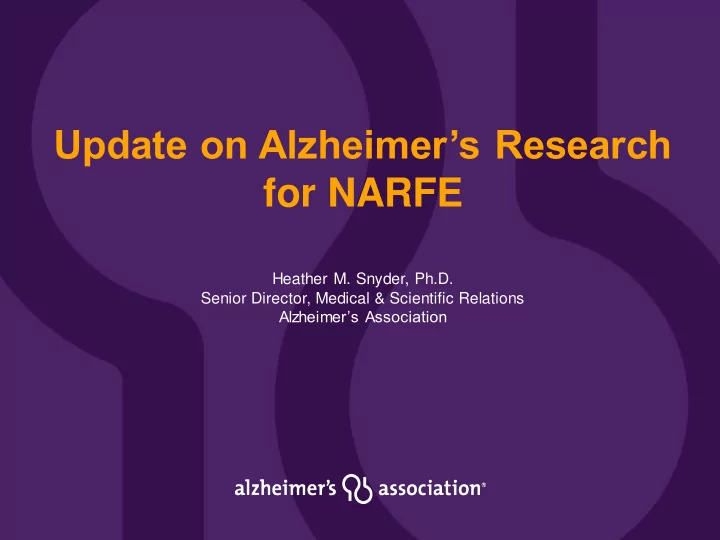

Update on Alzheimer’s Research for NARFE Heather M. Snyder, Ph.D. Senior Director, Medical & Scientific Relations Alzheimer’s Association
Types of Dementia 2
What is Alzheimer’s? • Alzheimer’s is a universally fatal brain disease • Alzheimer’s has a gradual onset • Alzheimer’s is progressive, meaning it gets worse over time • The vast majority of people develop “late onset” Alzheimer’s dementia (over age 65) 3
Impact of Alzheimer’s Dementia Continues To Grow $ 1.1 TRILLION IN 2050 2017 Alzheimer’s Association Facts & Figures 4
5
Alzheimer’s Association Funding the Future • World’s largest, most impactful non-profit funder of research; $380M since 1982 • Today, more than $100M active in 18 countries • Focus on innovative ideas from early career investigators • Emerging areas & gaps 6
Significant Advances Made Possible Because of NARFE! • Over $12 million funding 71 innovative scientific projects • Funding gaps & emerging areas, advancing the science to the next level • Research funded spans the full spectrum of science to better understand & treat Alzheimer’s disease • NARFE funded researchers are significantly advancing our understanding of disease, developing tools to improve diagnosis, and exploring diverse avenues for potential therapies 7
Both Association Funding and Federal Research Funding are Critical Federal Funding Association Funding Larger in scale Quickly deployed Breadth of coverage Precisely targeted Longer term Global scope sustainability Higher risk tolerance Association and federal research f unding don’t compete… they complement each other 8 8
History of Alzheimer’s Disease tangles plaques 9
Continuum of Alzheimer’s Disease Alzheimer’s disease Normal Adapted from Sperling et al. 2011 10
Advances in Early Detection Targeted biochemical Genetics Protein production & clearance rates Epidemiology Proteomics Structural Neuroimaging Neuropsychometric tests PET Imaging 11
NARFE Investigators Advancing Early Detection • 2015 award to Min Shi, Ph.D. (University of Washington) to study changes of tau as potential plasma biomarker of Alzheimer's • 2011 award to Joseph Goveas, MD (Medical College of Wisconsin) to investigate different kinds of imaging depressed adults at risk for Alzheimer’s • 2009 award to Barbara B. Bendlin, PhD (UW, Madison) to understand changes in brain vascular systems in middle age adults at risk by imaging 12
Pathway to Approval for Drug Development 75 Adapted from PhRMA Annual report 13
NARFE Investigators Exploring Diverse Potential Therapy Avenues • 2011 award to David Cribbs, PhD (UC, Irvine) on links of Cerebral Amyloid Angiopathy, inflammation & hypertension and 2012 award to Michael Agadjanyan, Ph.D. (Institute for Molecular Medicine) on immune response to vaccines; partnering together on a phase 1 trial • 2014 award to Charbel Moussa, Ph.D. (Georgetown University) on effects of Nilotinib on tau clearance in Alzheimer’s; funded by NIH and recruiting for participants now 14
Current Landscape of Clinical Trials for Alzheimer’s & Dementia Phase II Phase III Phase I 75 Total Trials 112 Total Trials 37 Total Trials 49 experimental 79 experimental 14 registration trials 5 for agitation or sleep medications medications 3 medical devise 7 medical devise 9 academic trials 9 diagnostic trials 6 diagnostic trials 2 medical devise 14 experimental 20 experimental 3 diagnostic trials 4 trials for non-AD medications for non- medications for non-AD AD dementias dementias dementias 13 Clinical trials with Computerized Devises for Alzheimer’s and Cognitive Decline for detection and / or cognitive training. As of 2/2017 15
Questions On Underlying Biology of Alzheimer’s in Women and in Men • X/ Y chromosomes genetic links disease related biology • Differences in brain function & networks as it relates to disease • Links of hormone levels (i.e. perimenopause) & energy metabolisms (i.e. shift from glucose to ketone energy usage) • Lifestyle factors (i.e. stress, metabolism, sleep) related to risk and/or reduced risk 16
Underlying Biology of Alzheimer’s in Women and in Men • X/ Y chromosomes genetic links disease related biology • Differences in brain function & networks as it relates to disease • Links of hormone levels (i.e. perimenopause) & energy metabolisms (i.e. shift from glucose to ketone energy usage) • Lifestyle factors (i.e. stress, metabolism, sleep) related to risk and/or reduced risk 17
Continuum of Alzheimer’s Disease Alzheimer’s disease Normal Adapted from Sperling et al. 2011 18
Collaboration for Alzheimer’s Prevention 19
What should I be doing now? 20
If we delay onset of Alzheimer’s by 5 years… 21
Thank you You are making a difference towards seeing a World without Alzheimer’s! 22
23
Recommend
More recommend